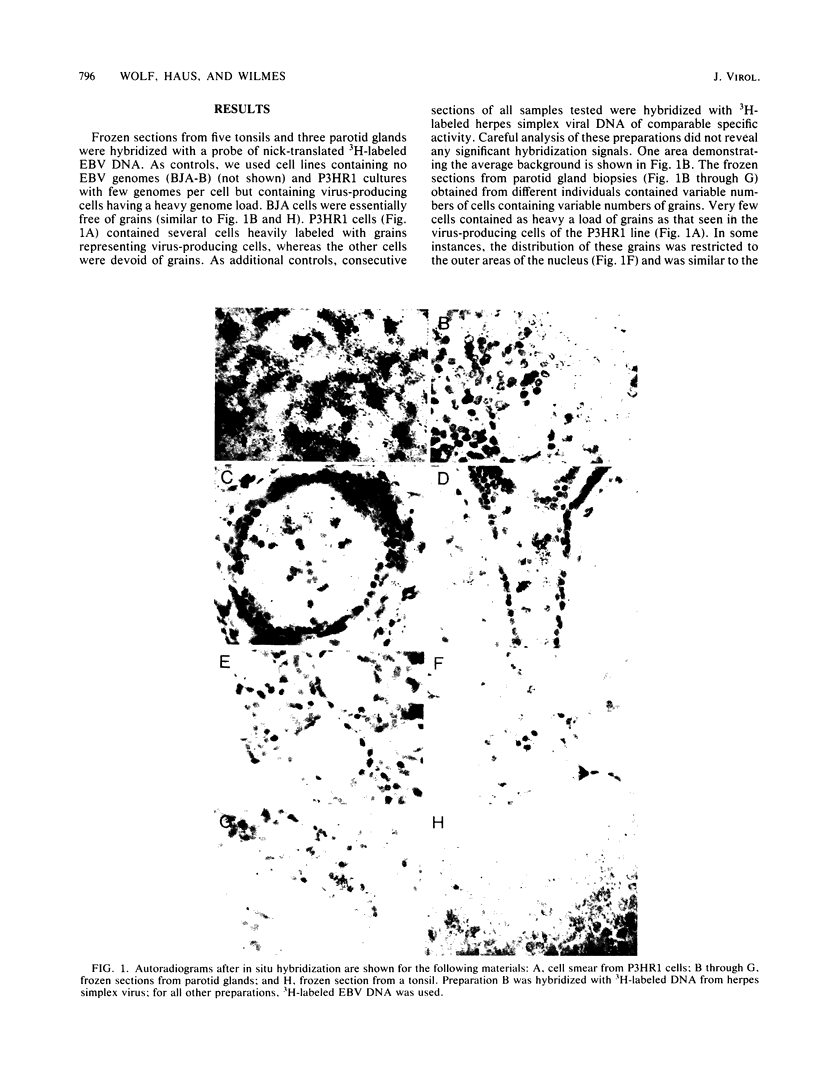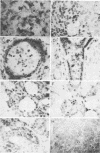Abstract
Two independent techniques, in situ hybridization on frozen sections and reassociation kinetics, have been used to localize Epstein-Barr virus genomes in tissue samples from healthy human adults. Whereas specimens taken from the palatine tonsils were invariably negative, all samples from the parotid gland were positive when tested with either technique. This observation suggests that the parotid gland is, besides the peripheral lymphocytes, a site of lifelong persistence of Epstein-Barr virus and probably the site of low-level virus production which may be the source of virus found in the oropharynx.
Full text
PDF



Images in this article
Selected References
These references are in PubMed. This may not be the complete list of references from this article.
- Bayliss G. J., Wolf H. The spontaneous and induced synthesis of Epstein-Barr virus antigens in Raji cells immobilized on surface coated with anti-lymphocyte globulin. J Gen Virol. 1981 Jun;54(Pt 2):397–401. doi: 10.1099/0022-1317-54-2-397. [DOI] [PubMed] [Google Scholar]
- Brahic M., Haase A. T. Detection of viral sequences of low reiteration frequency by in situ hybridization. Proc Natl Acad Sci U S A. 1978 Dec;75(12):6125–6129. doi: 10.1073/pnas.75.12.6125. [DOI] [PMC free article] [PubMed] [Google Scholar]
- Calnek B. W., Hitchner S. B. Localization of viral antigen in chickens infected with Marek's disease herpesvirus. J Natl Cancer Inst. 1969 Oct;43(4):935–949. [PubMed] [Google Scholar]
- Gerber P., Lucas S., Nonoyama M., Perlin E., Goldstein L. I. Oral excretion of Epstein-Barr virus by healthy subjects and patients with infectious mononucleosis. Lancet. 1972 Nov 11;2(7785):988–989. doi: 10.1016/s0140-6736(72)92402-6. [DOI] [PubMed] [Google Scholar]
- Golden H. D., Chang R. S., Prescott W., Simpson E., Cooper T. Y. Leukocyte-transforming agent: prolonged excretion by patients with mononucleosis and excretion by normal individuals. J Infect Dis. 1973 Apr;127(4):471–473. doi: 10.1093/infdis/127.4.471. [DOI] [PubMed] [Google Scholar]
- Jondal M., Klein G. Surface markers on human B and T lymphocytes. II. Presence of Epstein-Barr virus receptors on B lymphocytes. J Exp Med. 1973 Dec 1;138(6):1365–1378. doi: 10.1084/jem.138.6.1365. [DOI] [PMC free article] [PubMed] [Google Scholar]
- Morgan D. G., Niederman J. C., Miller G., Smith H. W., Dowaliby J. M. Site of Epstein-Barr virus replication in the oropharynx. Lancet. 1979 Dec 1;2(8153):1154–1157. doi: 10.1016/s0140-6736(79)92384-5. [DOI] [PubMed] [Google Scholar]
- ROWE W. P., HARTLEY J. W., CRAMBLETT H. G., MASTROTA F. M. Detection of human salivary gland virus in the mouth and urine of children. Am J Hyg. 1958 Jan;67(1):57–65. doi: 10.1093/oxfordjournals.aje.a119919. [DOI] [PubMed] [Google Scholar]
- WELLER T. H., CRAIG J. M. The isolation of mumps at autopsy. Am J Pathol. 1949 Sep;25(5):1105–1115. [PMC free article] [PubMed] [Google Scholar]
- Wolf H., Zur Hausen H., Klein G., Becker V., Henle G., Henle W. Attempts to detect virus-specific DNA sequences in human tumors. III. Epstein-Barr viral DNA in non-lymphoid nasopharyngeal carcinoma cells. Med Microbiol Immunol. 1975;161(1):15–21. doi: 10.1007/BF02120766. [DOI] [PubMed] [Google Scholar]
- Wolf H., zur Hausen H., Becker V. EB viral genomes in epithelial nasopharyngeal carcinoma cells. Nat New Biol. 1973 Aug 22;244(138):245–247. doi: 10.1038/newbio244245a0. [DOI] [PubMed] [Google Scholar]



